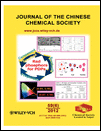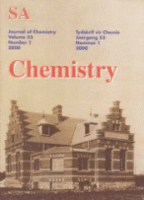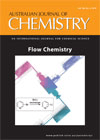
Ovidius University Annals of Chemistry
Scope & Guideline
Exploring the Frontiers of Chemical Research.
Introduction
Aims and Scopes
- Environmental Chemistry:
Focus on the chemical processes occurring in the environment, including studies on pollutants, waste management, and the impact of chemicals on ecosystems. - Analytical Chemistry:
Development and application of analytical techniques for the detection and quantification of chemical substances, including methods like HPLC, GC-MS, and spectroscopic analysis. - Organic and Medicinal Chemistry:
Research on the synthesis, characterization, and biological evaluation of organic compounds, particularly those with potential pharmaceutical applications. - Food Chemistry and Nutrition:
Investigation into the chemical composition of food products, food safety, and the nutritional aspects of various ingredients and additives. - Materials Science and Engineering:
Exploration of novel materials, their properties, and applications, including polymers, nanomaterials, and composites in various engineering contexts. - Chemical Education:
Research aimed at improving the methods and practices of teaching chemistry, focusing on innovative pedagogical approaches and curriculum development.
Trending and Emerging
- Green Chemistry and Sustainability:
Increased focus on environmentally friendly chemical processes and materials, reflecting global priorities on sustainability and reducing environmental impact. - Health and Risk Assessment:
Growing emphasis on assessing health risks associated with chemical exposure, particularly in food, water, and environmental contexts, showcasing the journal's commitment to public health. - Nanotechnology Applications:
Emerging research on the applications of nanomaterials in various fields, indicating a trend toward exploring their potential benefits and risks. - Biochemical Analysis and Functional Foods:
Rising interest in the biochemical properties of food and natural products, particularly those with health benefits, aligns with the increasing consumer demand for functional foods. - Waste Valorization and Recycling:
Research focusing on the innovative reuse of waste materials and by-products into valuable resources is gaining traction, highlighting the importance of circular economy principles.
Declining or Waning
- Traditional Chemical Synthesis:
Research focusing solely on classical synthetic methods has decreased, likely due to the growing interest in greener and more efficient synthetic pathways. - Basic Inorganic Chemistry:
Studies that strictly cover fundamental aspects of inorganic chemistry are becoming less common, possibly overshadowed by more applied and interdisciplinary research. - Corrosion Science:
While still relevant, the frequency of publications solely focused on corrosion mechanisms and inhibition has waned, as researchers increasingly integrate these studies within broader materials science contexts. - Basic Toxicology:
Basic toxicological studies without a focus on practical applications or environmental implications are less frequently published, as the journal's scope shifts towards more applied research.
Similar Journals

Chemical Bulletin of Kazakh National University
Fostering Global Dialogue in Chemical ResearchThe Chemical Bulletin of Kazakh National University is a prominent open-access journal dedicated to advancing the field of chemistry. Published by AL-FARABI KAZAKH NATIONAL UNIVERSITY, this journal serves as a vital platform for disseminating original research, reviews, and innovative findings in diverse areas of chemistry since its transition to open access in 2012. With an ISSN of 1563-0331 and an E-ISSN of 2312-7554, the journal aims to reach a global audience, fostering knowledge exchange among researchers, professionals, and students in the scientific community. The publication seeks to promote high-quality research that contributes to the understanding and application of chemical sciences, particularly in the context of Kazakhstan and the broader Central Asian region. Given the journal's commitment to making research freely accessible, it stands as an invaluable resource for anyone engaged in the study and application of chemistry.

JOURNAL OF THE CHINESE CHEMICAL SOCIETY
Navigating the Landscape of Chemical AdvancementsJOURNAL OF THE CHINESE CHEMICAL SOCIETY, published by WILEY-V C H VERLAG GMBH, is a vital resource in the field of chemistry, focusing on a broad array of topics pertinent to general chemistry and its advancing sub-disciplines. Established in 1954 and running through 2024, this journal serves as a significant platform for the dissemination of high-quality research, showcasing innovative findings and developments within the chemical sciences. With its Q3 category ranking and positioning at Rank #203 in General Chemistry per Scopus, it reflects the journal's commitment to research excellence and impact. While not an open-access publication, it ensures accessibility to a global audience, making it an essential tool for researchers, professionals, and students alike seeking to stay informed and engaged in the evolving landscape of chemistry.

CHINESE JOURNAL OF CHEMISTRY
Fostering dialogue and discovery in chemistry.The CHINESE JOURNAL OF CHEMISTRY, published by WILEY-V C H VERLAG GMBH, is a distinguished peer-reviewed journal that has been contributing to the field of chemistry since its inception in 1990. With an impressive Q1 ranking in the Chemistry (miscellaneous) category and a Scopus rank of 67 out of 408, this journal is recognized for its rigorous scholarly standards and significant impact within the academic community. Renowned for publishing high-quality research, reviews, and insightful commentaries, the journal serves as a vital resource for researchers, professionals, and students keen on advancing their understanding of general chemistry and its applications. Although it does not offer open access, the journal remains an essential outlet for innovative chemistry research, attracting contributions from a global network of specialists. With its broad scope covering various aspects of chemistry and a commitment to fostering scientific dialogue, the CHINESE JOURNAL OF CHEMISTRY is poised to continue its role as a central pillar in the ever-evolving landscape of chemical sciences.

RUSSIAN JOURNAL OF GENERAL CHEMISTRY
Connecting Innovators in Chemical ResearchThe Russian Journal of General Chemistry is a prominent scholarly publication dedicated to advancing the field of general chemistry. Published by MAIK NAUKA/INTERPERIODICA/SPRINGER, this journal contributes significantly to the global chemistry landscape, offering a platform for researchers and professionals to share their latest findings and methodologies. With an ISSN of 1070-3632 and an E-ISSN of 1608-3350, it has established itself as a resource for high-quality research articles since its inception in 1996. Though currently indexed in the Q4 category for chemistry (miscellaneous) and ranking #299 out of 408 in general chemistry according to Scopus, the journal remains an important venue for academic contributions that bridge gaps in traditional chemical disciplines. Desiring to cater to a diverse range of interests within chemistry, the journal actively encourages submissions that reflect significant scientific achievements, innovations, and collaborative studies. Although the journal does not currently offer open access, its role in disseminating crucial chemical research cannot be overstated. Researchers and students alike will find valuable insights and rigorous scientific discourse in its pages.

SOUTH AFRICAN JOURNAL OF CHEMISTRY-SUID-AFRIKAANSE TYDSKRIF VIR CHEMIE
Advancing Chemistry Through Open Access InnovationSouth African Journal of Chemistry (Suid-Afrikaanse Tydskrif vir Chemie), published by Bureau Scientific Publications, is a pivotal open-access journal that has been disseminating groundbreaking research in the field of chemistry since its inception in 1996. With an ISSN of 0379-4350 and an E-ISSN of 1996-840X, this journal serves as a vital platform for researchers and professionals seeking to share their work and engage with the global chemistry community. Recognized for its significant contributions, the journal holds a Q3 quartile ranking in the miscellaneous chemistry category as of 2023 and ranks #216 out of 408 in General Chemistry according to Scopus. The South African Journal of Chemistry is dedicated to advancing knowledge in the discipline by publishing a wide array of articles, reviews, and studies that address pertinent chemical research and applications. With open access options available since 2000, it fosters a collaborative environment, ensuring that research is accessible to all, thereby enhancing the visibility and impact of chemists' work across South Africa and beyond.

AUSTRALIAN JOURNAL OF CHEMISTRY
Fostering global collaboration in chemical sciences.The Australian Journal of Chemistry, with an ISSN of 0004-9425 and an E-ISSN of 1445-0038, is a distinguished publication from CSIRO PUBLISHING, dedicated to advancing the field of chemistry since its inception in 1948. Based in Australia, this journal serves as a platform for original research articles, reviews, and innovative studies that encompass a wide spectrum of chemical disciplines, aiming to foster communication and collaboration among researchers globally. Despite its Q3 ranking in the Chemistry (Miscellaneous) category and standing at rank #236 in Scopus’ general chemistry classification, it remains an essential resource for professionals and students seeking to stay informed about emerging trends and discoveries in chemistry. The journal does not offer open access, emphasizing the premium quality of peer-reviewed content that adheres to rigorous academic standards. By bridging theory and practice, the Australian Journal of Chemistry continues to play a crucial role in shaping the future of chemical sciences.

Moscow University Chemistry Bulletin
Connecting Researchers for a Brighter Chemical FutureMoscow University Chemistry Bulletin is a distinguished academic journal dedicated to advancing the field of chemistry, published by PLEIADES PUBLISHING INC. With an ISSN of 0027-1314 and an E-ISSN of 1935-0260, this journal provides a platform for researchers, professionals, and students to explore a wide range of topics in general and specialized chemistry. While it holds a current Q4 ranking in the “Chemistry (miscellaneous)” category according to Scopus, the journal is committed to broadening its scope and visibility, aiming for greater impact in the global scientific community. Moscow University Chemistry Bulletin focuses on the publication of cutting-edge research, reviews, and discussions that stimulate innovation and collaboration. Although it is not an Open Access journal, it plays a crucial role in disseminating knowledge and fostering academic dialogue within the field, as it converges towards significant findings from 2004 to 2024. The continuous development of its content holds the potential to attract a diverse readership, making it a valuable resource for those involved in the chemical sciences.

Journal of the Korean Chemical Society-Daehan Hwahak Hoe Jee
Cultivating a Global Dialogue in Chemical SciencesJournal of the Korean Chemical Society-Daehan Hwahak Hoe Jee, published by the esteemed Korean Chemical Society, serves as a vital platform for scientific communication in the expansive fields of chemistry and chemical engineering. Established in 2005, this journal showcases original research, reviews, and scholarly articles that contribute to the advancement of chemical sciences, promoting collaboration among researchers globally. Although it currently holds a Q4 category ranking in both Chemistry and Chemical Engineering on the Scopus platform, the journal remains committed to improving its standards and attracting high-quality submissions that reflect the latest innovations and discoveries. With an ISSN of 1017-2548 and an E-ISSN of 2234-8530, this journal provides invaluable resources for professionals, academia, and students dedicated to exploring novel ideas and fostering ongoing education in chemistry. Its location in Seoul, South Korea, places it at the heart of a vibrant scientific community, encouraging engagement and contributions that enhance the journal's profile within the international scientific discourse.

Journal of Chemistry and Technologies
Bridging Knowledge and Technology in Chemistry.The Journal of Chemistry and Technologies, published by OLES HONCHAR DNIPROPETROVSK NATIONAL UNIVERSITY, is an open access journal dedicated to advancing knowledge in the broad fields of chemistry and chemical engineering since its inception in 2013. With ISSN 2663-2934 and E-ISSN 2663-2942, this journal provides a vital platform for researchers and professionals, particularly in Ukraine and beyond, to share innovative research findings and contemporary technological advancements. Currently ranked in the Q4 quartile in both Chemical Engineering and General Chemistry for 2023, it serves as an enriching resource for those interested in emerging trends and interdisciplinary studies within these domains. The journal adheres to high academic standards while fostering collaboration in the scientific community by offering open access articles that ensure visibility and accessibility to a global audience. As an important part of the academic landscape, the Journal of Chemistry and Technologies aims to inspire future research and development, paving the way for new discoveries and applications in chemistry-related fields.

Vietnam Journal of Chemistry
Unveiling Cutting-Edge Discoveries in ChemistryVietnam Journal of Chemistry, published by WILEY, is a prominent academic journal that serves as a platform for the dissemination of innovative research in the field of chemistry. With its ISSN 0866-7144 and E-ISSN 2572-8288, this journal has made a significant impact on the global scientific community, evidenced by its 2023 Scopus ranking as #274 in the General Chemistry category and a commendable percentile of 32nd. The journal, categorized in the Q3 quartile for miscellaneous chemistry subjects, aims to foster communication among chemists from Vietnam and around the world, encouraging collaboration and the exchange of cutting-edge knowledge. While it currently does not offer Open Access options, the Vietnam Journal of Chemistry is committed to contributing valuable insights from its coverage years spanning from 2018 to 2024, making it a worthy resource for researchers, professionals, and students dedicated to advancing the field of chemistry. Based in the United Kingdom, it stands as a testament to the vibrant research endeavors emerging from Vietnam and beyond.